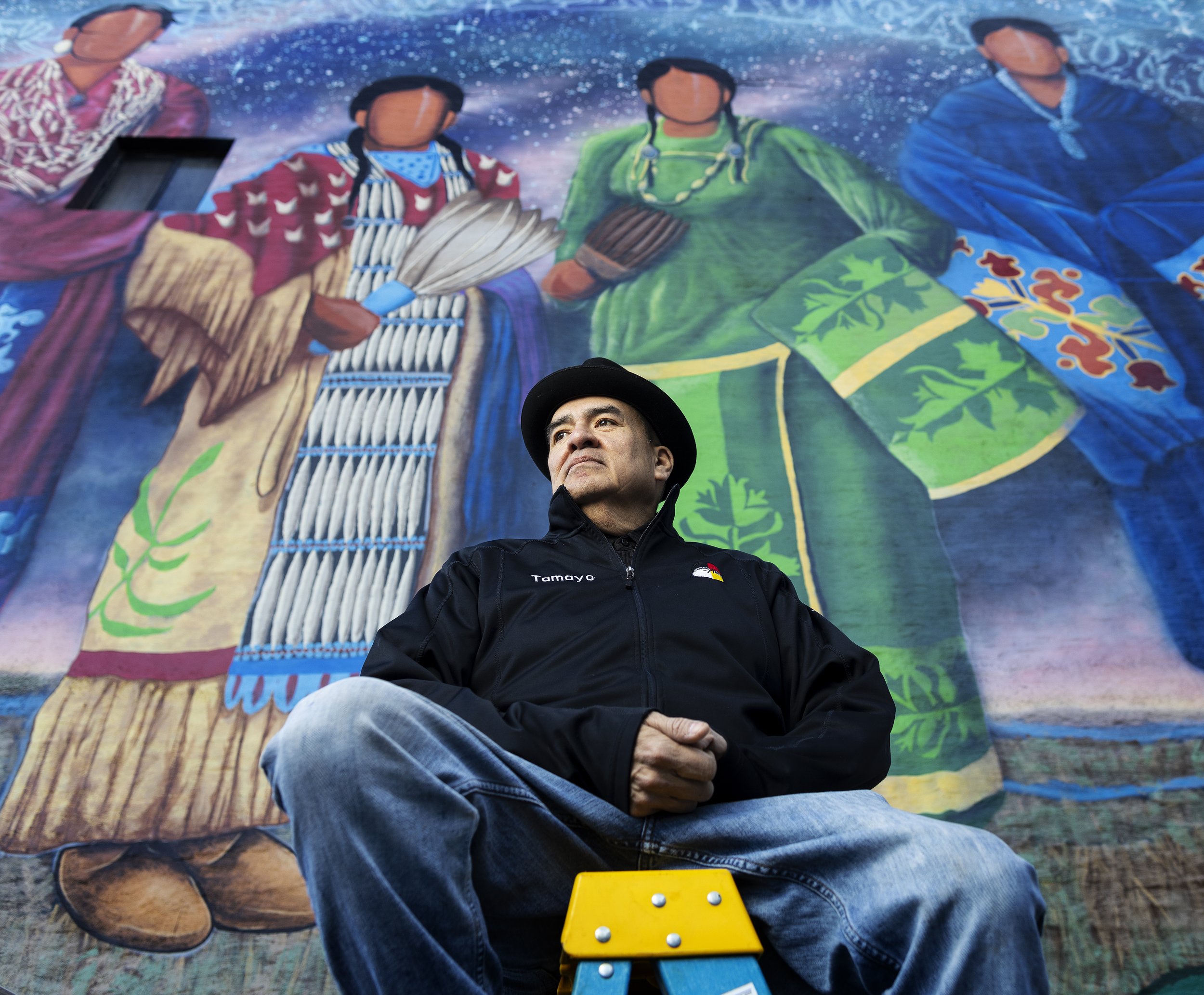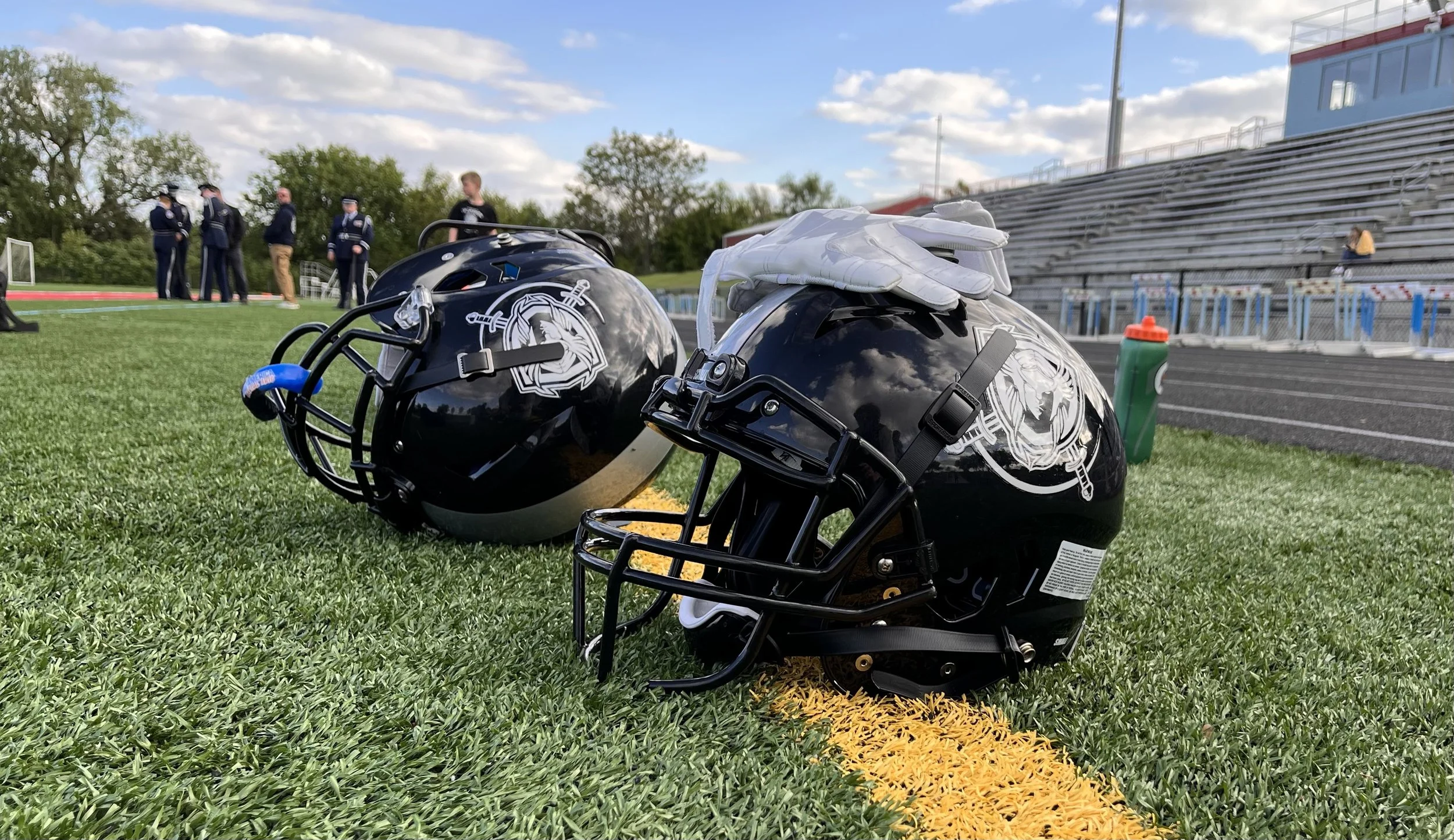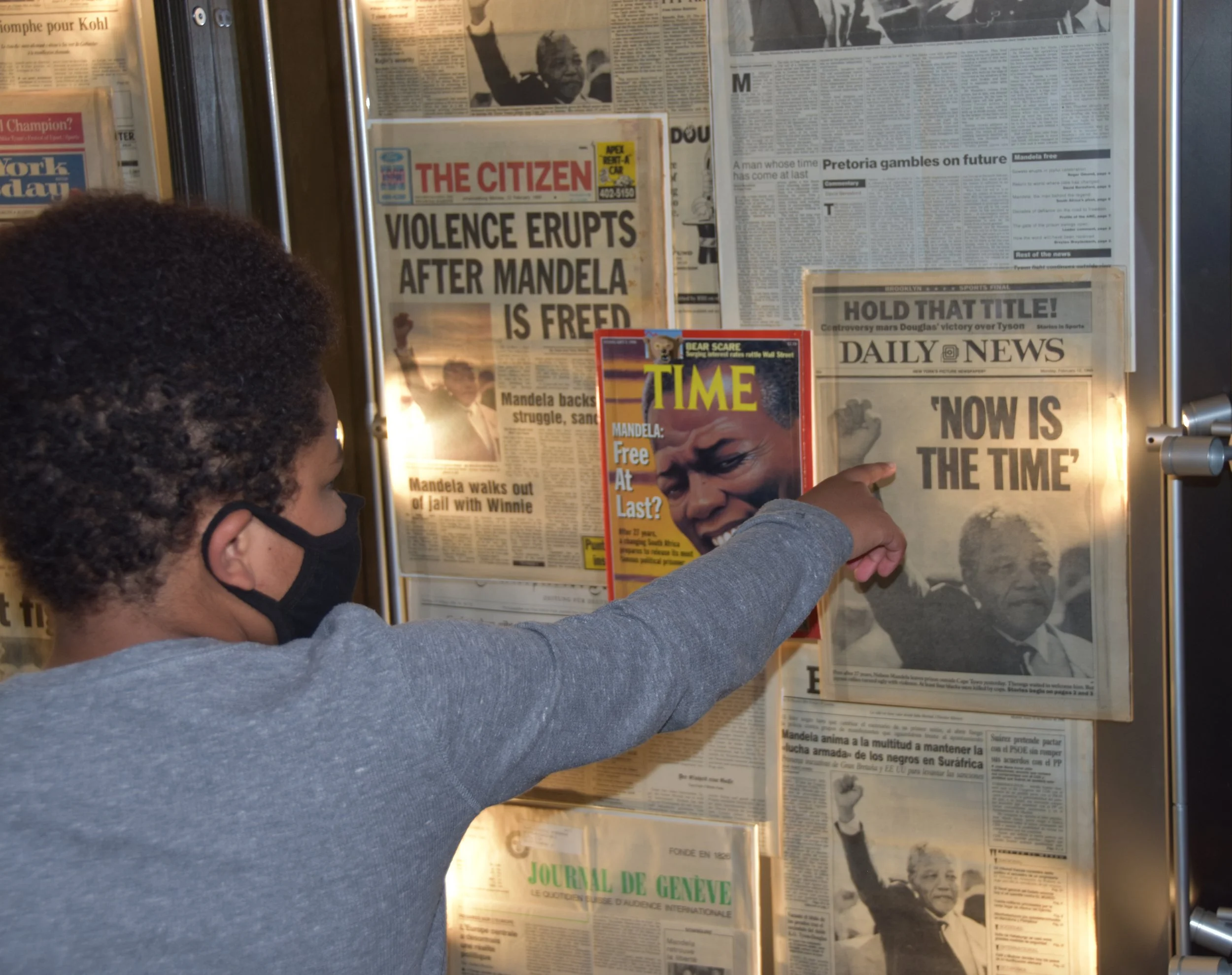New Way to Look at Famed Plains Paintings: Through Native Eyes
Lestina Saul-Merdassi poses for a portrait with the city of Omaha as the backdrop. Saul-Merdassi, a counselor, is reconnecting to her heritage through a new Nebraska art exhibit featuring Bodmer's famed watercolors of Native people. Photo by Ryan Soderlin for the Flatwater Free Press.
By Barbara Soderlin, Flatwater Free Press
It wasn’t until Vida Stabler was a teenager in the 1970s that she came face to face with her own people, the Umonhon, represented in artwork.
She walked with her Omaha Central High School art class, across the lawn north of the school, and into the Joslyn Art Museum next door.
What she saw there, in a collection of watercolors including a portrait called “Omaha Boy,” would influence her own life’s work as a cultural educator: a career of preserving and teaching the language and traditions of the people also known as the Omaha.
Decades later, that expertise brought Stabler, now 64, back to the museum and again in front of the paintings of famed artist Karl Bodmer. Now, it was she, not a curator, who commanded the audience’s attention.
Museum goers fanned out around her as she sat, twin braids falling past her shoulders, and pointed to the piece behind her on the wall: “Omaha Boy.”
What would his life have been like, she asked, this child of her own tribe who stood for a portrait in 1833? Who was he, this boy posing at a trading post just a few miles from where the art museum would be built, a century later, on the lands of the Umonhon?
The perspective Stabler brings to answering those questions is why Joslyn has invited her and other Native Americans – including people whose own tribal ancestors are depicted in the paintings – to take a leading role in the current exhibit, “Faces From the Interior.”
The exhibit, on display through May 1, features roughly 90 watercolor portraits Bodmer painted after an epic 1830’s journey up and down the Missouri River. His portrait subjects: Native people indigenous to the Northern Great Plains.
It’s fitting that the collection – considered a defining body of Western art and a cornerstone of the museum’s holdings – is on view so close to where Bodmer set up his easel.
But how the paintings got here was anything but guaranteed. They went back by boat to Bodmer’s studio in Paris and languished in a German castle before a 20th Century discovery brought them back to the United States. Omaha energy company Northern Natural Gas bought the collection and loaned it to the Joslyn in 1962. The loan became a gift in 1986, after Northern became Enron – but before Enron became synonymous with corporate scandal.
Since the ‘60s, several Joslyn exhibits have highlighted different aspects of the Bodmer collection.
“Faces” – the first focused solely on his portraits, not his landscapes – also represents the beginning of the museum’s effort to study the works from an Indigenous perspective, said Joslyn chief executive Jack Becker.
Lloyd Fritz, left, and Heidi Piccini, both of Lincoln, visit the Joslyn Museum in Omaha on Friday, March 18, 2022. Fritz and Piccini were at the museum exploring the exhibit “Faces of the Interior, The North American Portraits of Karl Bodmer.” Photo by Ryan Soderlin for the Flatwater Free Press
“It’s a collection that should be seen from multiple points of view,” Becker said. This created an opportunity for Native American artists, activists and educators to have a voice in how these works – their own family portraits – are displayed and interpreted.
Their insights tie the challenges their tribes wrestle with today to the pressures the United States’ western expansion and policies put on the people pictured. Visitors can walk through the gallery and see and hear these contributions: companion art pieces, video documentaries, written descriptions of the artwork and audio messages.
Stabler, speaking to the audience at a gallery talk, looked at the painting of the Umonhon boy standing in profile, wrapped in a bison robe. She saw his forehead and temples streaked with vermillion. She saw bangles circling his wrist, a plume tied in a lock of hair. His full cheeks. His round belly. “If ever I saw an elegant young Umonhon boy, that was him,” Stabler said.
She said he would have lived in a warm earth lodge, and learned by watching others how to collect wood and haul water. He would have learned the role of his tribal clan in the ceremonies that brought people together in a camp circle representing the cosmos.
Omaha Boy
Karl Bodmer’s 1833 portrait of Omaha Boy, watercolor and graphite on paper. The portrait is one of roughly 90 appearing in the Joslyn Art Museum’s current exhibit. Photo by Bruce M. White courtesy of the Joslyn Art Museum
He’s not very different, she said, from the children she teaches today, at Umonhon Nation Public School in Macy, a town of 1,045 people and the Omaha Reservation’s tribal seat.
“We’re resilient,” she said. “Even though we live in a whole different world, there is something beautiful and innate about our children.”
Stabler said her approach to preserving her language and teaching it to her students – not just orally, but in textbooks, so future generations can access it – was influenced by Bodmer and his employer.
In 1832, Bodmer was hired by a German prince, Maximilian of Wied-Neuwied, a naturalist on a mission to study and record the plants, animals and people who represented what he called “The natural face of North America and its aboriginal population.”
The prince, who had previously explored Brazil, sensed he was running out of time to study indigenous North America. Commerce, disease, settler encroachment and U.S. government policy had already uprooted, transformed and diminished Native tribes.
Arriving in Boston on Independence Day, 1832, Maximilian noted, “I looked in vain for the original American race, the Indians; they have disappeared from this region.” Steaming up the Missouri past Bellevue late in the spring of 1833, Maximilian saw survivors scarred and blinded by smallpox.
Maximilian’s journals and Bodmer’s paintings became a snapshot of Northern Great Plains tribes at a pivotal moment.
The two-year round trip fell squarely between Lewis and Clark’s Corps of Discovery Expedition, begun in 1804, and the Homestead Act of 1862. From open prairie, to private ownership, in less than one lifetime.
“Whereas some have erroneously held (Bodmer’s paintings) up as though they represented a lost world preserved in amber, we know that they offer instead a view of a world already on the cusp of calamitous change,” wrote Scott Manning Stevens, a Syracuse University Native studies professor and a member of the Akwesasne Mohawk Nation, in an essay tied to the exhibit.
These new interpretations of the Joslyn’s signature collection, through Indigenous eyes, are possible because of the way the artist saw his subjects, depicting them not as types, but as individual people of a certain time and place.
What Maximilian and Bodmer brought back to Europe in their journals and paintings is considered one of the most accurate records of the American West before photography. Bodmer’s approach was scientific, and he captured the detail of his subjects’ personal style, story and status, as expressed through their clothing, jewelry and adornments.
Artist Steve Tamayo studied the Bodmer painting “Wahktä́geli, Yankton Sioux Chief” to recreate the man’s feathered headpiece in three dimensions for the exhibit.
Tamayo, a member of the Sicangu Lakota tribe, worked in his home studio in Omaha’s Benson neighborhood, teaching his grandson, Izzy Tamayo, at his side. He cut cloth, trimmed eagle and hawk feathers, stretched sinew and deer hide, and mixed mineral pigments to craft the piece. Each notch in a feather, each red stripe, represents achievements in battle, he said.
Bodmer’s documentation is meaningful to Tamayo in light of government policy that aimed to strip Native people of culture and language.
Artist Steve Tamayo of Omaha, a member of the Sicangu Lakota tribe, poses for a portrait near a mural called “Ancestral Voices” on Monday, March 16, 2022. It is located near 24th and N streets in Omaha. Tamayo was a contributing artist in the mural’s creation. Tamayo studied the Bodmer painting “Wahktä́geli, Yankton Sioux Chief” to recreate the man’s feathered headpiece in three dimensions for the exhibit. Photo by Ryan Soderlin for the Flatwater Free Press
After a recent night teaching in an addiction treatment program through the Nebraska Urban Indian Health Coalition, he said, “Ninety percent have no idea about who they are or where they come from.”
As an artist and educator, he tries to revive cultural identity, calling it an important part of healing and empowerment.
Working with the Joslyn: “That’s an awesome opportunity to show that this way of life still exists, but we need to teach the next generation.”
Engaging with the portraits was one stop for Lestina Saul-Merdassi of Omaha on her own path to reconnect with her heritage. She greeted museum visitors at a gallery talk in the Dakotah language, then translated to English: “‘It’s good that you are all here, and I greet you all with a heartfelt handshake.’”
Looking up from her notes, she explained, “I had to read that off my phone, because I am in the process of relearning my language.”
Saul-Merdassi, a member of the Sisseton Wahpeton Oyate tribe, grew up in Yankton, South Dakota, gleaning pieces of Native history through museum artifacts. Today she’s an addiction counselor, a powwow dancer and an advocate in the movement to raise awareness about missing and murdered indigenous women, known as “MMIW.”
She saw herself in one of the few portraits Bodmer made of a woman.
Chan-Chä-Uiá-Te-Üinn
Karl Bodmer’s portrait of Chan-Chä-Uiá-Te-Üinn, Lakota Sioux Woman, 1833, watercolor and graphite on paper. Photo by Bruce M. White courtesy of the Joslyn Art Museum
“When we talk about our history, not everything is all powwows and beauty,” she told the audience. “Some of us are still healing from what our ancestors went through.” By turning to tradition, “We’re on the mend.”
The exhibit’s perspective is representative of an “orientation shift” happening in the art world, involving patrons, curators, artists and audiences, said exhibit curator Annika Johnson. It’s connected to growing advocacy and awareness around issues important to many Native leaders and activists, such as oil pipelines, sports mascots, the MMIW movement and political representation.
Johnson is the Joslyn’s first-ever associate curator of Native American art. Similarly, New York’s Metropolitan Museum of Art, where “Faces” debuted in 2021 before coming home to Omaha, appointed its first curator of Native American art in 2020.
Annika Johnson
The Bodmer exhibit curator, poses for a portrait on Monday, March 21, 2022, at the Joslyn Art Museum in Omaha, Nebraska. Johnson is the Joslyn’s first associate curator of Native American art. Photo by Ryan Soderlin for the Flatwater Free Press
The Joslyn role, originally funded by the New York-based Mellon Foundation, will continue into the future thanks to an endowment established by Joslyn board chair Stacy Simon.
Simon said she’s impressed with Johnson’s work to build relationships with Native people within and beyond museum walls. Johnson launched a Native art advisory committee, opens the Joslyn’s archives to Native elders and tribes on request and mentors Native students in museum- and art-related career paths.
The work to preserve and share Native art and history is crucial, Stabler said.
Yes, oral storytelling tradition is vital. But she learned something from the Bodmer collection.
“If we don’t write things down, maybe we’re going to miss something,” she said. “Will we have the time to teach that lesson, or tell that story? Or will they be forgotten?”
is Nebraska’s first independent, nonprofit newsroom focused on investigations and feature stories that matter.




















